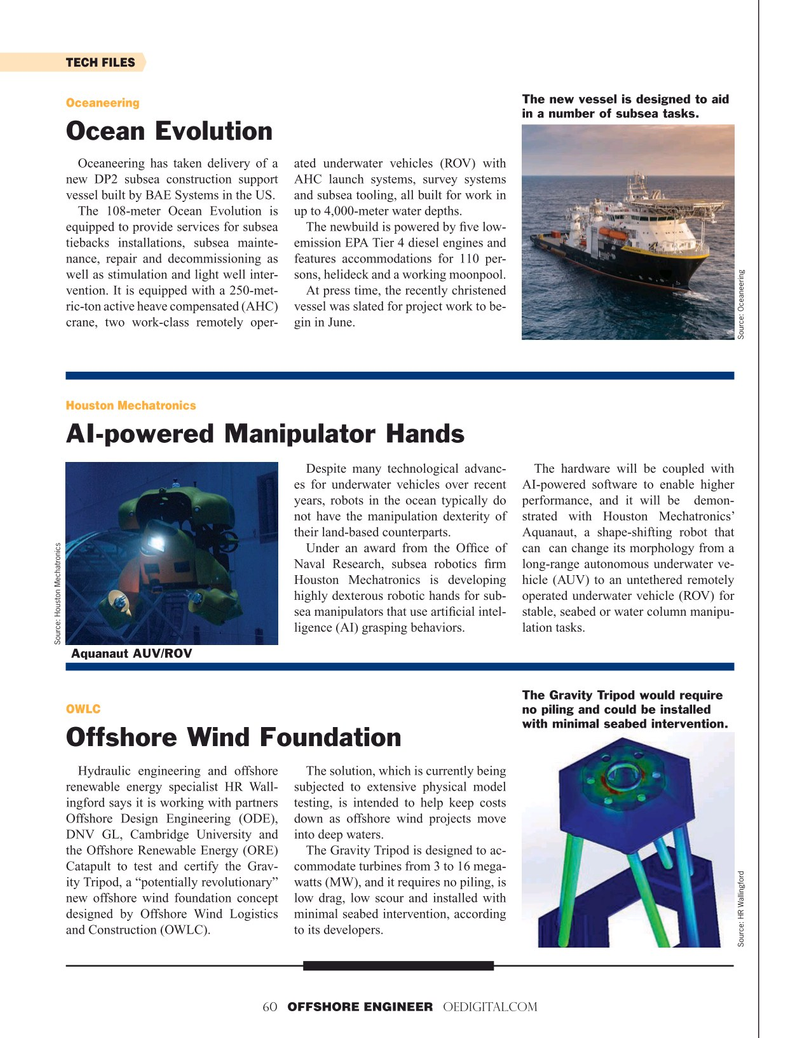
Page 60: of Offshore Engineer Magazine (May/Jun 2019)
Offshore Renewables Review
Read this page in Pdf, Flash or Html5 edition of May/Jun 2019 Offshore Engineer Magazine
TECH FILES
The new vessel is designed to aid
Oceaneering in a number of subsea tasks.
Ocean Evolution
Oceaneering has taken delivery of a ated underwater vehicles (ROV) with new DP2 subsea construction support AHC launch systems, survey systems vessel built by BAE Systems in the US. and subsea tooling, all built for work in
The 108-meter Ocean Evolution is up to 4,000-meter water depths.
equipped to provide services for subsea The newbuild is powered by ? ve low- tiebacks installations, subsea mainte- emission EPA Tier 4 diesel engines and nance, repair and decommissioning as features accommodations for 110 per- well as stimulation and light well inter- sons, helideck and a working moonpool.
vention. It is equipped with a 250-met- At press time, the recently christened ric-ton active heave compensated (AHC) vessel was slated for project work to be- crane, two work-class remotely oper- gin in June.
Houston Mechatronics
AI-powered Manipulator Hands
Despite many technological advanc- The hardware will be coupled with es for underwater vehicles over recent AI-powered software to enable higher years, robots in the ocean typically do performance, and it will be demon- not have the manipulation dexterity of strated with Houston Mechatronics’ their land-based counterparts. Aquanaut, a shape-shifting robot that
Under an award from the Of? ce of can can change its morphology from a
Naval Research, subsea robotics ? rm long-range autonomous underwater ve-
Houston Mechatronics is developing hicle (AUV) to an untethered remotely highly dexterous robotic hands for sub- operated underwater vehicle (ROV) for sea manipulators that use arti? cial intel- stable, seabed or water column manipu- ligence (AI) grasping behaviors. lation tasks.
Source: Houston Mechatronics
Aquanaut AUV/ROV
The Gravity Tripod would require
OWLC no piling and could be installed with minimal seabed intervention.
Offshore Wind Foundation
Hydraulic engineering and offshore The solution, which is currently being renewable energy specialist HR Wall- subjected to extensive physical model ingford says it is working with partners testing, is intended to help keep costs
Offshore Design Engineering (ODE), down as offshore wind projects move
DNV GL, Cambridge University and into deep waters.
the Offshore Renewable Energy (ORE) The Gravity Tripod is designed to ac-
Catapult to test and certify the Grav- commodate turbines from 3 to 16 mega- ity Tripod, a “potentially revolutionary” watts (MW), and it requires no piling, is new offshore wind foundation concept low drag, low scour and installed with designed by Offshore Wind Logistics minimal seabed intervention, according and Construction (OWLC). to its developers.
Source: HR Wallingford Source: Oceaneering 60 OFFSHORE ENGINEER OEDIGITAL.COM 50-64 OE MayJune 2019.indd 60 6/10/2019 10:54:49 AM

 59
59

 61
61